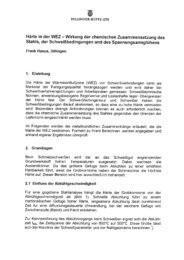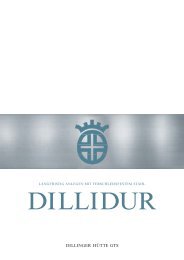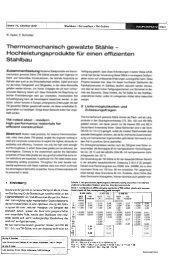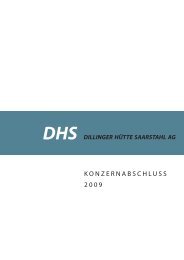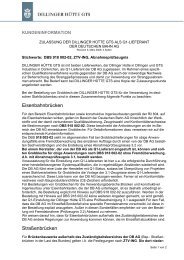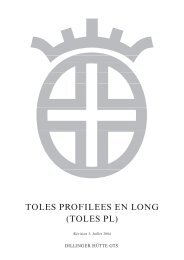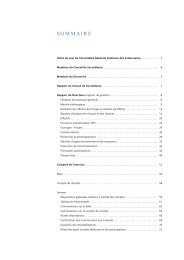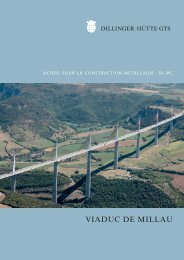Offshore Letter 2 2010 - Dillinger Hütte GTS
Offshore Letter 2 2010 - Dillinger Hütte GTS
Offshore Letter 2 2010 - Dillinger Hütte GTS
Create successful ePaper yourself
Turn your PDF publications into a flip-book with our unique Google optimized e-Paper software.
<strong>Dillinger</strong> <strong>Hütte</strong> - a plate producer with a long and proud tradition<br />
Production at Dillingen started with cast<br />
iron, the products being used to meet the<br />
needs of fortresses constructed in the<br />
surrounding area, and for military<br />
equipment. The raw materials for production<br />
were readily available nearby – wood and<br />
water, as energy sources, and low-grade iron<br />
ore located in easily recoverable form close<br />
to the surface. Even then, the mill operated<br />
in an economic environment that<br />
necessitated continuous refinement of the<br />
technologies used and the quality of the<br />
goods supplied to meet market requirements.<br />
Following initial forged plate<br />
products, the first rolled plate was produced<br />
more than 200 years ago. In addition to sheet<br />
iron for further processing to thin plate,<br />
heavy plates for various purposes were<br />
produced. This is now effectively <strong>Dillinger</strong><br />
<strong>Hütte</strong>’s “only” product.<br />
The 3.6 m rolling stand in Dillingen 1913<br />
The input at Dillingen for production of<br />
plates for the most diverse applications is<br />
impressive. The world’s first continuous<br />
caster for steel slabs was installed here more<br />
than fifty years ago, for example. Today,<br />
slabs with thicknesses of up to 400 mm<br />
can be cast, with special benefits for the<br />
production of plate for the offshore<br />
industry. Such heavy slabs can be used<br />
to achieve high plate weights, with<br />
significant economic advantages for the<br />
fabrication yards, thanks to the resultant<br />
reductions in welding costs. In addition,<br />
the high deformations of the material<br />
during the rolling process result in<br />
excellent mechanical properties at half<br />
thickness. Dillingen was also one of the<br />
leading pioneers in production of<br />
thermomechanically rolled plates. Material<br />
produced using this highly<br />
sophisticated process possesses welding<br />
properties significantly superior to those of<br />
conventionally rolled and normalized plates.<br />
<strong>Dillinger</strong> <strong>Hütte</strong> was also the first heavyplate<br />
producer to combine thermomechanical<br />
rolling and accelerated<br />
cooling by water in the rolling<br />
process. This innovation modifies<br />
the internal structure of the plate and<br />
improves mechanical properties<br />
even further. Develop-ment and<br />
production of this plate is always<br />
conducted in close cooperation with<br />
the customer. Indeed, <strong>Dillinger</strong><br />
<strong>Hütte</strong>’s 325-year evolution from a<br />
simple iron-maker to a producer of<br />
highly sophisticated plates would<br />
probably not have been possible<br />
without such intensive collaboration<br />
with customers.<br />
A look back over <strong>Dillinger</strong> <strong>Hütte</strong>’s 325-year<br />
history is highly instructive. This<br />
retrospective of the AG der <strong>Dillinger</strong> <strong>Hütte</strong>nwerke<br />
is an inspiration both to the<br />
company itself and to its customers. It<br />
The AG der <strong>Dillinger</strong> <strong>Hütte</strong>nwerke (<strong>Dillinger</strong> <strong>Hütte</strong>)<br />
celebrates its 325th anniversary this year. What does this<br />
mean for the steel user?<br />
Since 1685, Fe - the chemical element iron - has been the<br />
basis of virtually all products supplied by <strong>Dillinger</strong> <strong>Hütte</strong>.<br />
The production and use of scarcely any other material have<br />
been so greatly influenced by technological developments<br />
across such a long period as those of iron. What began as<br />
simple cast iron, with high carbon and impurity contents,<br />
has matured into a product which, thanks to the latest<br />
technologies, now meets the highest standards for<br />
mechanical and welding properties.<br />
demonstrates that the company is always<br />
following its vision to develop perspectives<br />
and technologies needed to achieve products<br />
which enable customers to select innovative<br />
and competitive materials in order to<br />
optimize the performance and competitiveness<br />
of their own projects and products.<br />
And also in future you can trust in <strong>Dillinger</strong><br />
products to achieve better and more<br />
economical solutions.<br />
Andreas Thieme<br />
(Marketing Manager)<br />
CONTENT<br />
Issue 2/<strong>2010</strong><br />
The 5.2 m rolling stand in Dillingen today<br />
<strong>Dillinger</strong> <strong>Hütte</strong> - a plate producer<br />
with a long and proud tradition 1<br />
More than just plate! 2<br />
Portrait of Vanessa Di Rosa 4
Since 1804, when the company’s first heavyplate<br />
rolling-mill was commissioned, the<br />
development of high-quality plate in<br />
numerous grades for a large range of<br />
specialized sectors - with ever greater<br />
dimensions and weights - continues today.<br />
Almost from the very start of plate<br />
production, fabrication of this product has<br />
also played an important role, however.<br />
It is only natural that not every customer has<br />
always been (or is) able to process and shape<br />
the plates supplied by <strong>Dillinger</strong> <strong>Hütte</strong>,<br />
particularly in the case of dimensions in the<br />
upper range, and especially when these are<br />
combined with elevated requirements for<br />
mechanical properties. In such situations –<br />
when Dillingen’s plate customers’ in-house<br />
manufacturing capabilities approach or reach<br />
their limits, either in terms of plate size (e.g.<br />
thickness, weight) or of production capacity<br />
- <strong>Dillinger</strong> <strong>Hütte</strong> <strong>GTS</strong> can assist by supplying<br />
not just the heavy plate material, but also ready<br />
fabricated structural plates and parts.<br />
The Heavy Fabrication Division exists for<br />
this purpose. The origins of this specialized<br />
sector at <strong>Dillinger</strong> <strong>Hütte</strong> can be traced back<br />
to the 19 th century; the decision to invest in<br />
greater forming capabilities –a 10,000 t<br />
steam-hydraulic press to supplement the<br />
5,000 t and 8,000 t presses already in place,<br />
The Heavy Fabrication Division’s possession<br />
of the latest generation of NC flame-cutting<br />
machines and equipment means that plates<br />
from the Dillingen supply range can be<br />
Figure 2: Cut-to shape ring segment for<br />
a hydro power plant, steel grade: S355J0+N,<br />
thickness 305 mm<br />
profiled with a right-angled edge and/or with<br />
edges prepared for welding (see Figure 2).<br />
In addition, they can also be supplied with<br />
enhanced cut-surface quality and waviness<br />
tolerances compared to standard requirements,<br />
as is necessary, for example, in<br />
the case of large cut racks for jack-up rigs<br />
(see Figure 3). Plates cut to shape and/or with<br />
oxycut beveled welding edges are used<br />
mainly in mechanical and structural<br />
engineering. For special tasks, the Heavy<br />
More than just plate!<br />
for example, and further expansion of<br />
welding facilities–was taken in the late 1800s<br />
(see Figure 1).<br />
Figure 1:<br />
<strong>Dillinger</strong><br />
history -<br />
year 1904:<br />
press shop<br />
with 10,000 t<br />
steam<br />
hydraulic<br />
press<br />
At that time, the Heavy Fabrication<br />
Division’s range of products and services<br />
focused on the needs of naval shipbuilding,<br />
heavy engineering and power-plant<br />
construction. In the 20 th century,<br />
development of the Heavy Fabrication Division<br />
was influenced, on the one hand, by<br />
the rapid development of <strong>Dillinger</strong> <strong>Hütte</strong>’s<br />
plate rolling-mill toward thicker, wider and<br />
heavier high-quality plates and driven, on the<br />
other hand, by plate customers’ requirements<br />
and their market activities, particularly in the<br />
fast-growing energy sector and in the oil and<br />
gas industry, including its downstream<br />
processing facilities.<br />
Plate cutting and trimming shop - cut-to shape and weld-edge beveled plates<br />
Figure 3: Cut racks for an offshore jack-up<br />
rig structure, steel grade S690Q, thickness up<br />
to 210 mm<br />
Fabrication Division can also make use of<br />
the facilities of the plate rolling-mill,<br />
featuring a plasma-cutting machine for plate<br />
thicknesses up to 100 mm and a water-jet<br />
cutting machine for thicknesses up to<br />
150 mm.<br />
Supply of edge-trimmed plates achieved by<br />
machining, for either rectangular, trapezoidal<br />
or annular plate shapes, is one of the Heavy<br />
Fabrication Division’s specialties. All plate<br />
edges, up to thicknesses of 120 mm, widths<br />
of 5,000 mm and lengths of 25,000 mm, can<br />
be machined to the very highest standards<br />
(see Figure 4). This extremely efficient plate-<br />
Today, the Heavy Fabrication Division is a<br />
fully integrated business unit within <strong>Dillinger</strong><br />
<strong>Hütte</strong> <strong>GTS</strong>, featuring its own sales<br />
organization, engineering team and<br />
fabrication facilities, and maintaining close<br />
ties with the various plate divisions at<br />
<strong>Dillinger</strong> <strong>Hütte</strong> <strong>GTS</strong> and with the company’s<br />
diverse interdisciplinary teams. These links<br />
generate great benefits for new and ongoing<br />
product developments, and therefore for<br />
users of heavy plate, since innovations in<br />
steelmaking and plate production, on the one<br />
hand, and experience in the processing of<br />
these products - especially in forming and<br />
welding methods - on the other, interact and<br />
complement each other ideally.<br />
In addition to its foundry, the Heavy<br />
Fabrication Division also operates three<br />
facilities for plate working - a plate cutting<br />
and trimming shop, a plate roll-bending and<br />
welding shop, and a press shop - enabling<br />
the division to supply a broad selection of<br />
parts and services for a whole series of<br />
industries. The Heavy Fabrication Division’s<br />
range of plate-working machines - many of<br />
them the most powerful of their type in the<br />
world - and its state-of-the-art technology<br />
permit performance of many highly<br />
specialized fabrication operations on<br />
<strong>Dillinger</strong> <strong>Hütte</strong> <strong>GTS</strong> plate.<br />
processing technology is of particular benefit<br />
to fabricators of structural tubulars, such as<br />
are used, for example, in the construction of<br />
offshore piles, for the penstocks of hydro-<br />
Figure 4: Plate edge-milling machine with<br />
trapezohedral and annular-shaped plates<br />
during processing<br />
electric power plants, and for storage tanks<br />
(including rolled-to-radius plates, see<br />
Figure 5). The excellent cut-face quality -<br />
with no undesirable hardening - and high<br />
level of accuracy achieved assure special<br />
advantages for subsequent welding,<br />
particularly where high-performance welding<br />
equipment is to be used (see Table 1 and<br />
Figure 6). This latest-generation milling<br />
machine can also perform special operations,
including de-cladding and tapering, on all<br />
welding edges.<br />
To assure optimized solutions throughout the<br />
supply chain, plates with ready-prepared<br />
welding edges (individually marked and weldedge<br />
coated) can be delivered “pile-wise” and<br />
Figure 6: Weld-edged prepared plates<br />
“just-in-time” for special projects, even in<br />
cases in which the welding-edge section is<br />
not specified when the order for the plate<br />
is placed. This flexibility is possible only<br />
thanks to close cooperation between the<br />
customer and the DH-<strong>GTS</strong> team, including<br />
Figure 5: Weld-edged prepared plates, rolled detailed tracking and analysis of projects<br />
to radius, ready for shippment<br />
and delivery schedules.<br />
Roll bending and welding shop - cylindrical shell courses<br />
Figure 7: 4-roll-bending-machine during the<br />
cold bending of a shell course welded out of two<br />
plates, steel grade: 20MnMoNi4-5<br />
thickness: 146 mm, diameter: 7300 mm<br />
Figure 9: Cut-back hemispherical head, steel<br />
grade: SA387-22-2 (N+ACC+T),<br />
thickness: 190 mm<br />
The pressing shop operates a number of<br />
hydraulic presses exerting press forces of up<br />
to 4,000 t. Single-piece vessel heads featuring<br />
no welds – simply hot formed by means of<br />
deep-drawing using a ring/mould and die –<br />
can therefore be supplied in a wide range of<br />
geometries, including spherical (up to<br />
Shell courses are produced by means of hot<br />
or cold forming, depending on shell size,<br />
material and/or code requirements. They are<br />
generally supplied fully welded, but are also<br />
optionally available in only tack-welded or<br />
braced form. The Heavy Fabrication Division<br />
also possesses a smaller four-roll<br />
bending machine for shaping of standard<br />
plates and another four-roll bending<br />
machine, which remains unique in the<br />
world, for bending of upper-range plate<br />
sizes and/or materials featuring higher<br />
mechanical strength properties (see<br />
Figure 7). The shell course products are<br />
typically used as structural elements, either<br />
as complete parts or in welded assemblies<br />
(see the example shown in Figure 8).<br />
The pressing shop: single-piece vessel heads and multi-segment shell sections<br />
3,700 mm in diameter, see the example in<br />
Figure 9), torispherical, elliptical and flat<br />
(diameter: up to 4,700 mm).<br />
Where the customer’s requirements exceed<br />
the potentials for production of single-piece<br />
components, the Heavy Fabrication Division<br />
can also supply multi-segment shell<br />
sections (produced using either hot or cold<br />
Figure 10: Conical transition piece and multi<br />
segment sections<br />
Table 1: Tolerances: “macroscopic” on the<br />
beveled plate, “microscopic” on the machined<br />
weld edge<br />
Figure 8: Shell course for an offshore-rig<br />
made of two half sections (tack-welded and<br />
braced), steel grade: S460Q, thickness: 210<br />
mm (cold rolled!)<br />
Figure 11:<br />
“Bell mouth”<br />
for the cable<br />
capture -<br />
offshore<br />
application<br />
forming, see the example in Figure 10).<br />
The available range also includes tailormade<br />
sections, including transition pieces,<br />
tapered segments and inlets for shaft linings,<br />
since there are then no dimensional<br />
restrictions (see example in Figure 11).<br />
Available services include trial assembly for<br />
shop inspection and supply of the finishwelded<br />
component.
Additional processing services, inspection and documentation<br />
• Heat treatment (normalizing, water quenching, tempering or stress-relieving – see Figure 12)<br />
• Inspection by destructive and/or non-destructive testing (within the <strong>Dillinger</strong> Inspection Dptmt)<br />
• Machining and/or weld-edge preparation (e.g. by vertical-lathe with 6m-diameter, cutting by<br />
hand or by thermal-cutting-robot – see Figure 13)<br />
• Welding (SMAW, SAW, TIG)<br />
The documentation includes an inspection certificate in<br />
Figure 12: conformity to EN 10204. Special fabrication and inspection<br />
Heat procedures, such as quality plans and/or shop drawings, can<br />
treatment also be provided on request, however. The Heavy Fabrication<br />
of heads Division is certificated in conformity to the following<br />
or shell standards: EN 9001, EN 14001, OHSAS 18001, ASMS S,<br />
courses ASMS U, ASME U2. Auditing for accreditation as an<br />
ASME III NPT-stamp holder and MO is currently taking<br />
place.<br />
Downstream fabrication and services<br />
<strong>Dillinger</strong> <strong>Hütte</strong>’s Heavy Fabrication Division is the right address if you need tailor-made prefabricated structural plates, individual parts,<br />
or complete packages providing all-in solutions. The Heavy Fabrication Division is a business unit fully integrated into the <strong>Dillinger</strong> <strong>Hütte</strong><br />
<strong>GTS</strong> organization and located on the same site as the plate-making facilities.<br />
<strong>Dillinger</strong> <strong>Hütte</strong> traditionally supports its heavy-plate customers’ outsourcing strategies. Irrespective of the processes involved – cutting,<br />
dishing, bending, forming, welding or machining – <strong>Dillinger</strong> <strong>Hütte</strong>, with its world-leading plate-processing technologies, is committed to<br />
top quality and reliable on-time delivery.<br />
Get the benefits of the <strong>Dillinger</strong> <strong>Hütte</strong> Heavy Fabrication Division’s professional expertise and comprehensive service, under our guiding<br />
principle of<br />
“More than just plate!”<br />
Patrick A. REGNERY<br />
(Heavy Fabrication Division)<br />
The Heavy Fabrication Division’s delivery program is intended only to provide an impression of the various formats and dimensions<br />
which can be supplied. Please contact us if you require formats, weights, fabrication operations, etc., not expressly included in the<br />
program.<br />
Stavanger, August 24 - 27, <strong>2010</strong><br />
Hall C Stand 342, German pavilion<br />
Vanessa Di Rosa<br />
I studied mechanical engineering at the Saarbrücken<br />
University of Applied Sciences, and<br />
started an internship in a department of the<br />
Heavy Fabrication Division, Foundry<br />
Section, at <strong>Dillinger</strong> <strong>Hütte</strong> in late 2006,<br />
subsequently writing my degree thesis on<br />
topics associated with the experience I<br />
gained there. A year later I joined the Health<br />
and Safety department, moving in March<br />
2008 to Marketing, where my activities focus<br />
mainly on the <strong>Offshore</strong>, Structural Tubulars<br />
and Linepipe sectors, and also on<br />
Earthmoving & Mining Equipment and the<br />
Visit us at the ONS fair<br />
Marketing Department <strong>Offshore</strong>, Structural Tubulars, Linepipe<br />
Born: 1980 in Saarlouis<br />
Education: Graduate mechanical engineer<br />
Hobbies: Sport, travel, arts<br />
<strong>Dillinger</strong> <strong>Hütte</strong> Steel Service Centers. In<br />
addition to the promotion of <strong>Dillinger</strong> <strong>Hütte</strong><br />
products, my responsibilities also<br />
include answering technical and<br />
commercial enquiries, with expert<br />
assistance from DH’s internal specialists<br />
where appropriate. Prompt and<br />
comprehensive support for customers and<br />
close cooperation with colleagues are<br />
vitally important factors in my work:<br />
‘Coming together is a beginning, staying<br />
together is progress, and working together<br />
is success’ is a quotation, from Henry Ford,<br />
that I agree with wholeheartedly.<br />
Figure 13: Weld-edge preparation<br />
of one-piece heads, shell courses<br />
or multi-segment section by robot<br />
Impressum<br />
Editor: Andreas Thieme<br />
Co-Editor: Vanessa Di Rosa<br />
DILLINGER HÜTTE <strong>GTS</strong><br />
P.O. Box 1580<br />
66748 Dillingen/ Saar, Germany<br />
Phone: +49 68 3 47 21 46<br />
Fax: +49 68 3 47 99 21 46<br />
E-Mail: marketing-offshore@dillinger.biz<br />
http:\\www.dillinger.de







